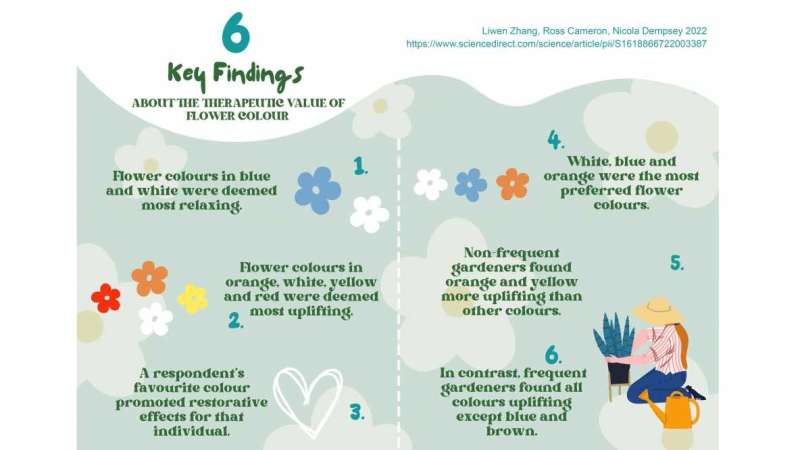Credit: Urban Forestry & Urban Greening (2022). DOI: 10.1016/j.ufug.2022.127795
In a new article, the Department of Landscape Architecture's Professor Ross Cameron and Ph.D. student Liwen Zhang describe their study, "Flowers—Sunshine for the soul! How does floral color influence preference, feelings of relaxation and positive up-lift?" published in Urban Forestry & Urban Greening.
Their research investigates how flower color influences mood, and how that may in turn affect well-being.
Roses are red, violets are blue, but which one is restorative to you?
Garden and landscape designers have long used flower and foliage color to create mood in the landscape. Pastel, cool colors such as blues, purples and pale pinks are thought to relax people and create a sense of calm. In contrast, hot, bold reds, yellows and oranges demand attention and "get the blood pumping."
In recent years, however, as science starts to better understand the relationship between the natural world and human well-being, we have begun to question what aspects of the landscape are particularly good for our health and well-being and what factors less so.
This is a critical point for those landscape designers who are commissioned to design restorative and other forms of therapy gardens. They are challenged with deciding what should be in the mix and what should not? A point made more difficult in that users have different mental health needs.
Which color flowers?
Green is considered relaxing, but what about flowers colors? If we want to reduce people's stress levels, what flower colors should we consider in the design?
Does science back the notion that pastel purples and misty blues are best? Also, should we always be wishing to reduce stimulation and promote tranquility?
Some emotional responses that relate to human health may be aligned with pleasant surprise, intrigue and happiness. Bright colors promote uplift and regular experiences of this can help ward off some mental health problems.
The recent study investigates how flower color influences mood, and how that may in turn affect well-being.
In this research, 670 U.K. residents were surveyed to examine their preferences and emotional responses to flower color using computer-generated images of daisy-like flowers, in eight separate colors.
Respondents found flowers in blue and white most relaxing, while hot colors, such as orange, yellow and red, were deemed most uplifting. Interestingly, white was seen by some as not only relaxing but also uplifting. White, along with blue and orange were the most preferred colors, at least for this flower form.
Although the data largely confirmed previous ideas that blue can relax the brain, and oranges, yellows and red stimulate it, a more surprising result was also uncovered.
Personal preferences
This suggested that an individual's preference for a particular color also elicited positive psychological benefits, irrespective of what that color was. In effect, favored colors have a separate restorative effect that acts at a personal level.
So, for example, for those people for whom purple is a favorite color, approximately 50% of them found it to be the most relaxing color and 50% the most stimulating. This is despite the fact that in the overall population, purple was not deemed particularly uplifting or relaxing.
These findings have significance for landscape architects: While certain flower colors can be used to promote "generic" therapeutic responses in appropriate locations, components of any designed landscapes still need to take account of personal responses and preferences.
Landscapes need a diversity of flower colors to maximize the therapeutic benefits across the population and should not be overly reliant on blue themes for relaxation and hot colors for stimulation.
More information: Liwen Zhang et al, Flowers—Sunshine for the soul! How does floral colour influence preference, feelings of relaxation and positive up-lift?, Urban Forestry & Urban Greening (2022). DOI: 10.1016/j.ufug.2022.127795
Provided by University of Sheffield
























